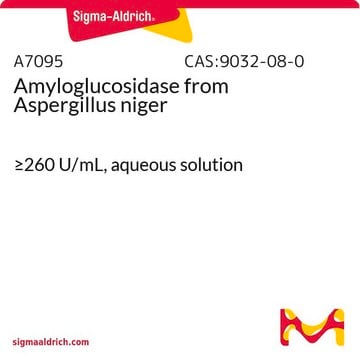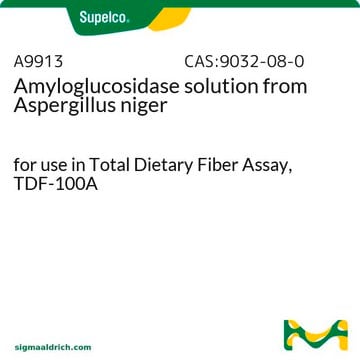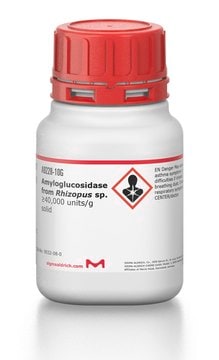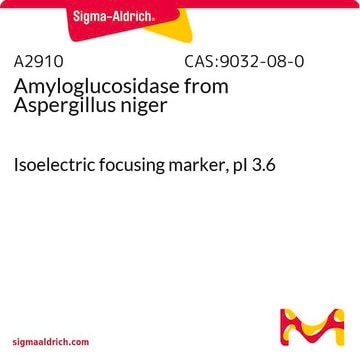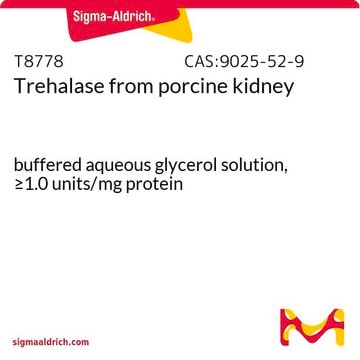This product is filled by density, with a target fill volume of 0.5 ml for the 25mg and 2.0 ml for the 100mg package sizes.
Kluczowe dokumenty
A1602
Amyloglucosidase from Aspergillus niger
ammonium sulfate suspension, ≥40 units/mg protein
Synonim(y):
1,4-α-D-Glucan glucohydrolase, Exo-1,4-α-glucosidase, Glucoamylase
Wybierz wielkość
358,00 zł
Wybierz wielkość
About This Item
358,00 zł
Polecane produkty
Formularz
ammonium sulfate suspension
aktywność właściwa
≥40 units/mg protein
Warunki transportu
wet ice
temp. przechowywania
2-8°C
Szukasz podobnych produktów? Odwiedź Przewodnik dotyczący porównywania produktów
Powiązane kategorie
Opis ogólny
Zastosowanie
Działania biochem./fizjol.
Definicja jednostki
Postać fizyczna
Inne uwagi
Kod klasy składowania
12 - Non Combustible Liquids
Klasa zagrożenia wodnego (WGK)
WGK 2
Temperatura zapłonu (°F)
Not applicable
Temperatura zapłonu (°C)
Not applicable
Środki ochrony indywidualnej
Eyeshields, Gloves, multi-purpose combination respirator cartridge (US)
Wykazy regulacyjne
Wykazy regulacyjne dotyczą głównie produktów chemicznych. Można w nich podawać ograniczoną liczbę informacji na temat produktów niechemicznych. Brak wpisu oznacza, że żaden ze składników nie znajduje się w wykazie. Użytkownik odpowiada za zagwarantowanie bezpiecznego i zgodnego z prawem stosowania produktu.
EU REACH Annex XVII (Restriction List)
Wybierz jedną z najnowszych wersji:
Certyfikaty analizy (CoA)
Nie widzisz odpowiedniej wersji?
Jeśli potrzebujesz konkretnej wersji, możesz wyszukać konkretny certyfikat według numeru partii lub serii.
Masz już ten produkt?
Dokumenty związane z niedawno zakupionymi produktami zostały zamieszczone w Bibliotece dokumentów.
Klienci oglądali również te produkty
Produkty
Instructions for working with enzymes supplied as ammonium sulfate suspensions
Protokoły
This procedure may be used for the determination of Amyloglucosidase activity using starch as the substrate.
-
What volume of ammonium sulfate is the 25mg suspended in?
1 answer-
Helpful?
-
-
How can a 1mg/mL solution of amyloglucosidase A1602 be prepared in acetate buffer?
1 answer-
The product A1602 is in an ammonium sulfate solution. Here's how you can work with this product:
- If the ammonium sulfate might interfere with the reaction(s):
1. Remove the enzyme from the refrigerator, ensuring that the ammonium sulfate suspensions are not frozen.
2. Gently invert the vial or bottle to produce a milky suspension. Avoid using harsh treatments like vortexing or sonicating, as they may denature some of the enzyme.
3. Use a pipette and sterile wide-bore pipette tip to remove a portion of the suspension.
4. Transfer the portion to a clean microcentrifuge or centrifuge tube.
5. Pellet the enzyme by centrifuging at approximately 10,000 – 15,000 x g for 10 minutes, if possible, using a refrigerated microcentrifuge set to a temperature between 2 °C and 8 °C.
6. Carefully remove as much clear supernatant as possible, retaining it; it is not necessary to remove absolutely all of the ammonium sulfate solution.
7. Dissolve the pellet by adding an appropriate amount of reaction buffer.
8. Assay the supernatant and the solution from the pellet for protein content and/or enzyme activity.- If the ammonium sulfate will not interfere with the reaction(s), follow the same steps as above.
It's important to note that for an ammonium sulfate suspension, most of the enzyme will be in solid form, and only negligible amounts of enzyme will likely be in the ammonium sulfate solution.
Alternatively, there are several Amyloglucosidase enzymes available in solid form (e.g., Product A7420 and A9228) that can be suspended in a solvent of your choice.
Helpful?
-
Active Filters
Nasz zespół naukowców ma doświadczenie we wszystkich obszarach badań, w tym w naukach przyrodniczych, materiałoznawstwie, syntezie chemicznej, chromatografii, analityce i wielu innych dziedzinach.
Skontaktuj się z zespołem ds. pomocy technicznej